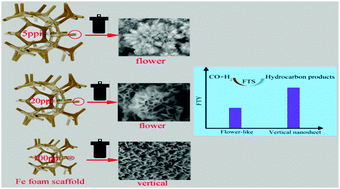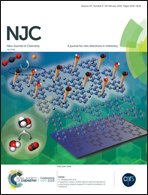Substrate-induced hydrothermal synthesis of hematite superstructures and their Fischer–Tropsch synthesis performance†
Abstract
A series of Fe foam substrates with different skeleton diameters are employed to control the growth of three dimensional (3D) α-Fe2O3 hierarchical architectures through a straightforward hydrothermal method. In addition, several attempts such as using an iron wire substrate, iron foil substrate, and a blank experiment (in the absence of any substrates) and two different iron precursors (FeCl2·4H2O and FeCl3·6H2O) were done for verifying the sensitivity between the substrate and the crystal structure. The Fe foam substrate with a small skeleton diameter (90 μm) facilitates the formation of α-Fe2O3 vertical nanosheet arrays, whereas flower-like α-Fe2O3 superstructures prefer to grow on the Fe foam substrate with a large skeleton diameter (200 μm and 600 μm). The synthesized two classical nanostructures are applied in the industrially relevant Fischer–Tropsch synthesis (FTS) reaction and they exhibit distinct FTS performance. The vertical nanosheet arrays show better FTS activity due to their large specific surface area, facile carburization ability, robust adhesion with the substrate and efficient contact of each nanosheet with feed gas. In addition, the electron-rich nanosheet structure suppresses the secondary hydrogenation of olefins, resulting in its lower methane selectivity, higher C5+ selectivity and C2–C4 O/P.



 Please wait while we load your content...
Please wait while we load your content...